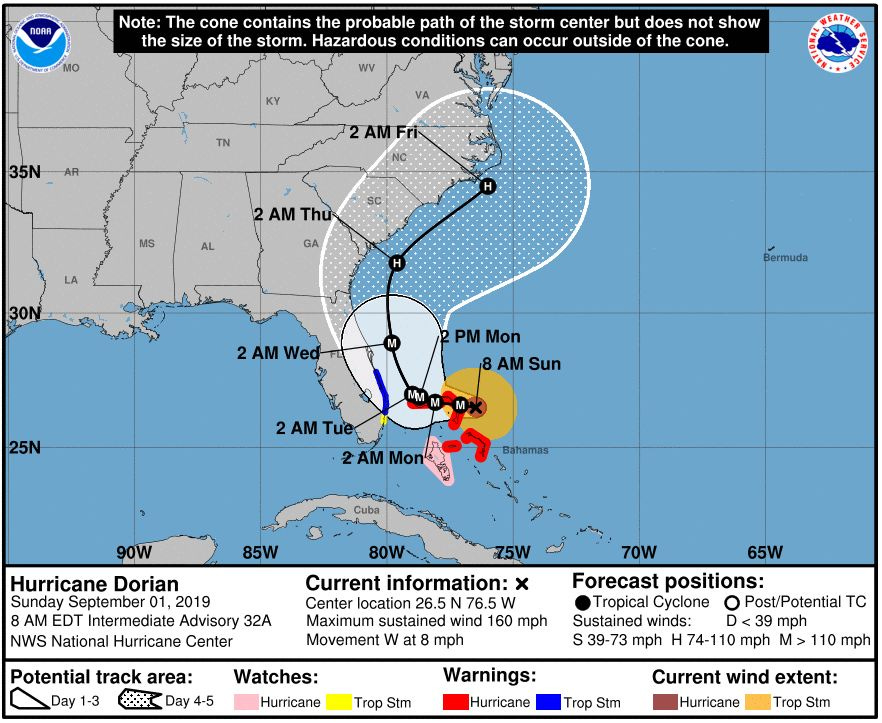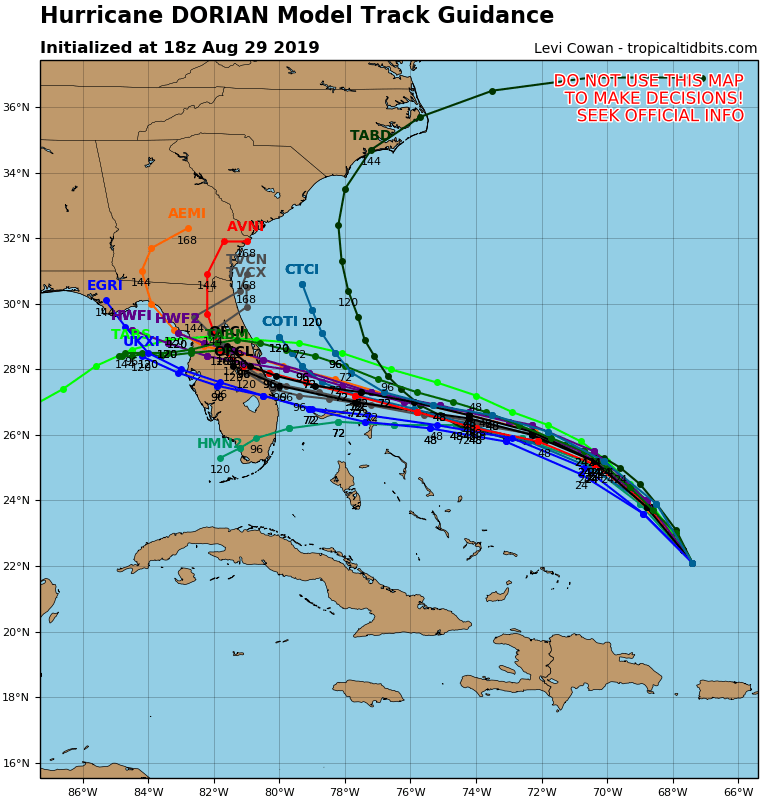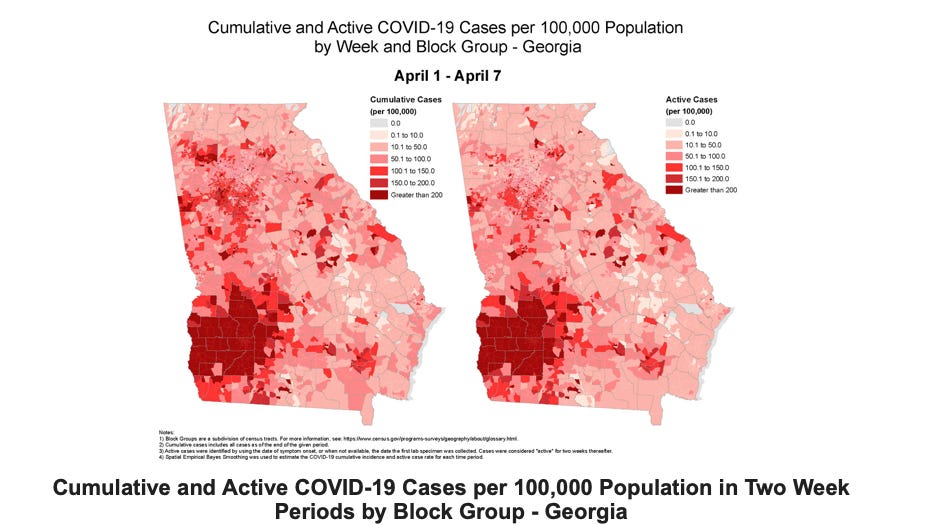I am in the camp that says the models were never supposed to be right. They were supposed to help guide. In the same way, a hurricane model helps determine where a hurricane might go. Remember Hurricane Dorian? The modeling helped get the east coast of Florida locked down, but also impacted the west coast of Florida pretty big time too.

Dorian then ultimately shifting and didn’t quite go where the modeling suggested. As new data came in, the models shifted and showed it would go up the eastern seaboard.

I use Dorian intentionally because the original modeling suggested Alabama would be impacted. The President mentioned Alabama in his press conference and the media pounced on him for saying so, even though reporters on CNN had said the same.
This led to the famous sharpie-gate situation where the President drew on the map and the idiots in the press suggested he has committed some criminal act. Let’s also not forget that the maps above are, essentially, composite guidance drawn from a bunch of models that in original form looked like this.

It turns out the models overwhelmingly showed the hurricane crossing Florida. Only three models showed it turning up the eastern seaboard. The Governor of Florida acted responsibly and as data changed, the models changed. By the time Hurricane Dorian was at Florida’s door, we had an accurate picture of where it was going from the real-time data combined with refining the models along the way.
It should not be controversial to say that this is no different, except in one major way. We have fewer epidemiological models with which to guide us. So we rely on the IHME model and the Imperial College model and the Oxford model. Oxford has been at the very low end. Imperial College has been at the high end. The IHME wound up being the one everyone takes seriously.
Even then, like with the path of the hurricane in the top two pictures, it shows a very wide range of deaths from around 40,000 to 150,000 deaths. We will hit the low end and most of that will be in New York City.
Taking the Models Seriously
To some degree, we almost have too much transparency. The wide availability of the models has allowed people to nitpick them, pick them apart, and otherwise raise questions as nonexperts that have reasonable answers, but sound sinister to other nonexperts.
Couple that with a healthy distrust on the right for expertise these days because of some very understandable reasons, and we hit peak distrust sooner than we hit medical resource peak in the modeling.
Frankly, from my vantage point, if the models wanted to be sinister and give government the tools to take away your civil liberties, they would have undercounted the deaths and spread instead of overcounting. Then we’d be in an “oh my gosh, the models are wrong and more peopel are dying” nightmare scenario where government would be rushing in to shut you down right now.
But just consider something
Look at the places that actually took the modeling seriously versus those that did not.
New Orleans and New York City have been devastated by the virus. It has brutally hit their medical infrastructure. Also, the local governments in those cities were not taking the models seriously until it was too late. The virus was able to spread into the cities, the retirement homes, etc. because the Mayor of New Orleans was encouraging Mardi Gras and the Mayor of New York was encouraging St. Patrick’s Day.
Meanwhile, on the West Coast and elsewhere, mayors and governors sprang into action decisively, shut down cities, large gatherings, and ultimately states. They took the models seriously and will not see the nightmare scenarios.
Consider Albany, GA. A preacher preached a funeral and did not know he was infected. It began spreading in the community. As it started spreading, other parts of Georgia started shutting down voluntarily. The result has been Southwest Georgia got clobbered, but the virus was largely contained there. Per capita, the major urban areas of Georgia responded quickly, even before the Governor of Georgia stepped in.
The modeling helped shape their thinking. You can see the results.

Governor Brian Kemp kept the open way past the time local officials wanted him to shut it down. Only when the models showed Georgia would exceed hospital bed capacity did he shut it down. People were painting nightmare scenarios, but he relied on experts who relied on the models who saw no signs of Georgia’s medical infrastructure being overwhelmed.
Once the modeling shifted, Governor Kemp sprang into action, shut down the state, and the result is the models predicted a May 1st peak and now show the peak was April 7th and we are well on the way to a full decline in the spread.
The irony here is that Democrats in Georgia attacked Kemp and claimed if he would have shut down in March, we’d see a peak in early April. He didn’t shut down the state until April 2nd and the peak came April 7th.
Now, Let Me Add One More Thing
I include this not to pick on Brian Stelter. But consider these tweets:


The situation in New York City is brutal. It is terrible and there is no excuse for it. Brian Stelter and the bulk of the American national press corps is in New York City and witnessing this first hand. It is clearly getting to all of them. It should.
I have a friend who is a doctor in New York who was blowing me up on a near daily basis in February that I was overstating the situation, I was wrong, and it was not going to be bad. He now tells me how wrong he was, it is terrible, they cannot keep up with the people dying in hospitals, let alone the people dying at home, and he is too scared to even go home to his family at night.
Consider also the bulk of the press loathes President Trump. You get a sense of this from Stelter’s tweet. “Journos are living this.” The President regularly attacks journalists and Stelter is one and of them and is protective of them. He is also in New York City.
From this, I can make an extrapolation.
The worst is over, assuming we are competent enough to keep it from spreading again when we all go outside.
But a lot of the press coverage is going to be relentlessly doom and gloom for much longer because of the New York City situation. Couple that with their hatred of the President and it is going to make for a rapid disconnect with Americans not living in New York City.
Areas like Los Angeles, Chicago, Atlanta, and Dallas are not nearly as impacted as New York. That suggests not a failure of the President, but a failure of Bill De Blasio and possibly Andrew Cuomo.
We are not going to find a real willingness to go after Cuomo because he is popular with a New York-centric press. To the extent they go after De Blasio, who is not popular, the press will undoubtedly try to weave a larger national narrative about Trump’s failures.
But, again, when you look around the country, mayors and governors responded and did so based on data and modeling. Blast them if you need to for economic destruction, but the mayors and governors chose to listen to their healthcare experts and their cities and states will not fare nearly as bad as New York City.
But Trump!





I always argued against a national shutdown, and I think Kemp might have been smart to act a little sooner, particularly for the Metro area. I read the statement from the governor of Montana and I appreciate the caution mixed with sense. I agree with the president that there are places that can and should begin to reopen because they were not so badly hit (for whatever reason). I think governors should consider having conversations with city leaders to test the idea of restarting economies based on the availability of treatment facilities to population.
I think schools could reopen in the fall--especially if the-powers-that-be provide smaller classes to encourage continued physical space. Smaller classes would also allow teachers to differentiate instruction and meet each student's needs.
Churches could probably reopen if they remind people that the personal bubble is still important. churches with chairs instead of pews could space them out a bit. Restaurants could reduce seating capacity for a while, but reopen dining rooms. Large events (concerts, sports, and festivals) should probably be on hold for a while.
I do know that the current all-or-nothing mentality is doing an awful lot of damage to the economy of small businesses. I also think that law-enforcement should not hand out tickets for violating the 6-foot recommendation (as is happening in some places). A reminder is sufficient; everyone knows what's going on. If people insist on congregating, they will suffer the consequences. At some point, personal responsibility has to be at play.
That was very interesting thanks for the insight